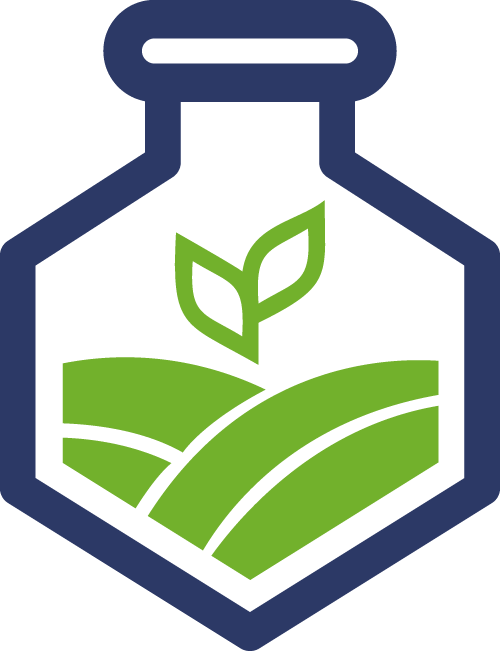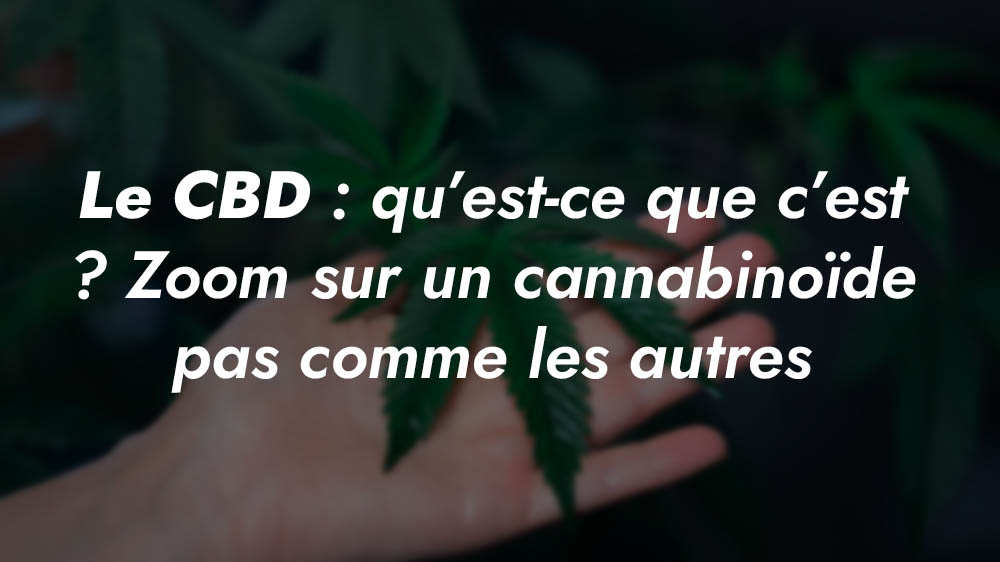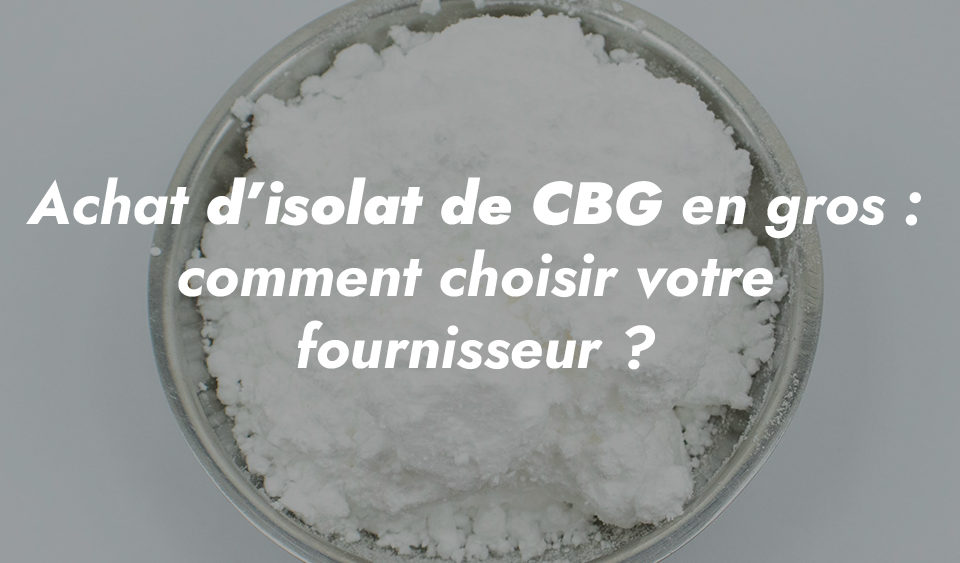
The UN commission reclassifies cannabis, which is no longer considered a risky drug.
December 3, 2020
CBG: what is cannabigerol?
December 15, 2020CBD is a mysterious acronym that's not always well understood, despite its growing popularity. As specialists in the field, we couldn't wait any longer - we absolutely had to get the word out about it.
But before anything else, let's get off to a good start.
Cannabidiol (CBD) is a cannabinoid. A cannabinoid is a chemical substance found in cannabis plants. There isn't just one cannabinoid, there are over a hundred , including one we all know about: THC, the molecule responsible for the psychotropic effects of cannabis.
Far less popular than its sidekick THC, CBD is nevertheless the talk of the town. But why? That's what we're going to explain!
CBD, what is this cannabinoid?
Cannabis sativa
If you've been following along, you'll have understood that CBD is found in cannabis sativa. In other words: hemp... or cannabis. By the way, what's the difference?
None, in the botanical sense.
In reality, the term hemp refers to plants used for industrial purposes. When we speak of cannabis, we're referring to either recreational or therapeutic use.
And there are many species of cannabis sativa. They can be distinguished by their size, the appearance of their leaves, and above all by their THC and CBD concentration.
Marijuana contains between 5% and 25% THC and less than 1% CBD. Therapeutic cannabis contains around 5% CBD and less than 0.2% THC.
As you can see, cannabinoids have the potential to regulate our body's functions. And CBD is proving to be a key molecule!
Therapeutic cannabis is legal, because it contains very little THC and has no psychotropic effects. That's why you can buy it without any problems.
Cannabidiol synthesis
Your intuition may be telling you that CBD is synthesized in cannabis flowers, just like its sidekick THC. And you'd be right.
CBD biosynthesis takes place in specialized glands, which develop with the formation of bracts, i.e. in the plant's trichomes. And, like THC, it is more prevalent in female plants. In fact, CBD and THC share the same precursor: cannabigerol (CBG).
CBG is another cannabinoid. Like its counterparts, it deserves to be better known!
We've just written an article on the subject: What is CBG?
During flowering, the plant secretes CBGA (acid version of CBG).
Aided by photosynthesis (which provides energy, among other things), CBGA is broken down into three cannabinoids: CBG, THC and CBD. The proportions depend on the variety and external conditions such as exposure to light and humidity.
How CBD is extracted from Cannabis
CBD is therefore synthesized in cannabis flowers. That's all very well, but how do you extract it?
Well, there are three main techniques:

Oil extraction
As you may know, cannabinoids have a strong affinity with fatty substances. CBD can therefore be extracted by immersing the plant's trichomes in heated, filtered oil. This method is natural, so the product is completely harmless. However, it is rarely used in industry, as CBD extracted in this way does not keep well.

Chemical solvent extraction
As always, there is a slightly less natural, not very expensive, but much more effective alternative. Certain substances such as alcohol, butane or propane can be used to extract CBD quite simply. But the resulting product contains residues, so it's not pure, and nowhere near as healthy as it claims to be!

Supercritical CO2 extraction
The last solution for extracting our CBD is complex to set up and quite expensive. But it's by far the best way to obtain the highest quality CBD product. Without going into too much technical detail, to separate CBD we use CO2, at the boundary between the liquid and gaseous states.
Alternatively, there's the synthetic version of CBD. It is obtained from genetically modified yeast.
By the way, who discovered CBD?
That's a good question! And for once, we've put our best digital pen to paper to give you the long and short of it. Don't hesitate to read: The amazing story of CBD.
To sum up his story (which goes back to prehistoric times!), we'll give you just one name: Raphaël Mechoulam.
Although it's not quite accurate to give him all the credit, this gentleman is considered the father of CBD. It was he who formally identified the molecular structure of CBD (and THC for that matter).
The chemical formula of cannabidiol (CBD) is C21H30O2 and the chemical formula of Tetrahydrocannabinol (THC) is C21H30O2.
Yes, you read that right (and no, it's not a typo): THC and CBN have the same chemical formula.
But then... why does one induce psychotropic effects while the other is studied for its therapeutic properties?
Far be it from us to create a little suspense. But... the answer lies in the next few paragraphs...
What effects does cannabidiol have on the body?
Its action on the endocannabinoid system
THC and CBD have the same chemical formula, but not the same structure. In other words, their atoms are not organized in the same way. And that makes all the difference!
Cannabinoids, and thus THC and CBD, act like neurotransmitters, meaning that to be activated, they need to connect to their receptor. And it's precisely the chemical structure that determines which receptor corresponds to which cannabinoid. A bit like puzzle pieces in the end...
Here's why CBD and THC don't have the same effects: they don't act on the same receptors.
THC has more affinity with a receptor known as CB1. CBD, on the other hand, prefers CB2.
By the way, where are these receivers?
They're everywhere in our bodies: mainly in the spinal cord and brain, but also in the lungs, heart, intestine, spleen, urinary tract... In short, a veritable network! A network we call the endocannabinoid system (ECS).
And this famous SEC plays a crucial role.
In fact, it regulates many of our functions, such as body temperature, pH and motor function... And fortunately, there's no need to consume any substance to activate it: our bodies produce cannabinoids naturally.
Endocannabinoid = cannabinoid synthesized naturally by the body. Phytocannabinoid = cannabinoid synthesized by cannabis (THC, CBD, CBN, CBG, etc.).
As you can see, cannabinoids have the potential to regulate our body's functions. And CBD is proving to be a key molecule!
Scientific studies on cannabidiol
Following the discovery of SEC in 1988, research into the therapeutic effects of CBD accelerated and discoveries became more precise. To date, there are numerous studies demonstrating the many possible therapeutic applications of CBD:
- Researchers at the University of Bologna have demonstrated that CBD is capable of restoring our body's biological equilibrium, acting in particular on temperature, acidity and sugar levels. The same observations were reported in another study, this time conducted in the United States.
- According to this other study, published in 2019, CBD stimulates the production of a well-known hormone: serotonin. The happiness hormone, for its part, acts on stress and sleep quality, among other things. Another study confirms CBD's potential antidepressant effect.
- In 2019, a study carried out on 8 volunteers with spinal cord injuries highlighted the possible pain-relieving properties of CBD.
- This study shows that CBD is an excellent vasodilator. It could also help treat eye pressure problems.
And the list goes on! Other promising results have also been observed. For example, according to this study, CBD appears to have a soothing effect on the epidermis. As for this study, it highlights its antibacterial power.
Over the past twenty years, CBD has been the subject of over a hundred published studies. The molecule is of growing interest to the pharmaceutical industry, so scientific research will continue, and it's safe to say that CBD is set to turn the world of medicine upside down. This natural alternative could indeed replace some of the more cumbersome treatments associated with numerous side-effects.
What do we know about the side effects of CBD?
But natural does not mean harmless. And could CBD, however beneficial it may seem, be potentially dangerous to humans?
It's hard to give a definitive answer to this question.
Nonetheless, some researchers have taken a closer look at the subject. According to a team of German scientists (from the private Nova Institute), CBD has only "tolerable" side effects. These include diarrhea, fatigue and changes in appetite.
Another study, this time by researchers at the University of Melbourne, also tends to demonstrate our body's high tolerance of CBD, although the researchers did note that the molecule can also cause headaches, in addition to the aforementioned side effects.
Like any substance, CBD acts differently on different organisms. Some people will be more sensitive to it, while others will see no noticeable effect.
CBD: a booming market
Why use CBD?
In France, the sale and consumption of CBD is regulated, but authorized. However, its therapeutic virtues are not guaranteed by the ANSM (Agence Nationale de Sécurité du Médicament).
In other words, sellers and resellers of CBD products cannot vouch for the therapeutic benefits of CBD.
Despite this, more and more people of all ages and social classes are clicking on "order" or pushing open the door of a store. And contrary to what you might think, these are not recreational cannabis users looking for a legal product.
No doubt motivated by the many sources of information, which are increasingly accessible, most CBD consumers appreciate the small molecule for its possible therapeutic benefits.
They're looking for a natural alternative to antidepressants, anxiety, insomnia or chronic pain. Many former smokers (tobacco or recreational cannabis) inhale CBD in the hope of satisfying their craving.
Some patients with cancer, fibromyalgia, diabetes or psychiatric illnesses such as psychosis and personality disorders find CBD use beneficial.
One thing's for sure: everyone is free to inform themselves, and to use the molecule as they see fit. Of course, caution is called for, and it's best to consult a health professional.
CBD products: cannabidiol in all its forms
CBD comes in all shapes and sizes, as long as it's not in the presence of its famous sidekick THC. Once again, THC is an illegal substance, and CBD products are strictly regulated in this respect: THC levels must not exceed 0.2%.
Whatever the case may be, there's no shortage of reasons why CBD consumers use it, andthere's no shortage of cannabinoid-based products either!
Here are some of the most popular CBD products.
Of course, there are all kinds of products formulated with CBD: sprays, edibles, beauty creams and so on.
Where can I buy quality CBD products?
We're delighted to see that the industry is bo oming, and to witness the arrival of new players. It's getting easier and easier to get CBD, and that's great news.
Beware, however, that as always, not all the high-growth markets are home to quality products. Some even border on the legal, with THC levels that don't meet the standards imposed by French legislation.
If you're thinking of buying CBD, we strongly recommend that you take the time to find out more.
The CBD Guide is a directory of online and brick-and-mortar stores offering CBD products. To be included in this directory, these retailers have been thoroughly vetted by industry professionals.
Like any consumer product, CBD is sold :

Online :
You'll generally have more choice than you would in a store, and prices are often more attractive because retailers have low overheads.

In store :
The advantage here is that you can talk to the seller, clarify your doubts and benefit from expert advice.





